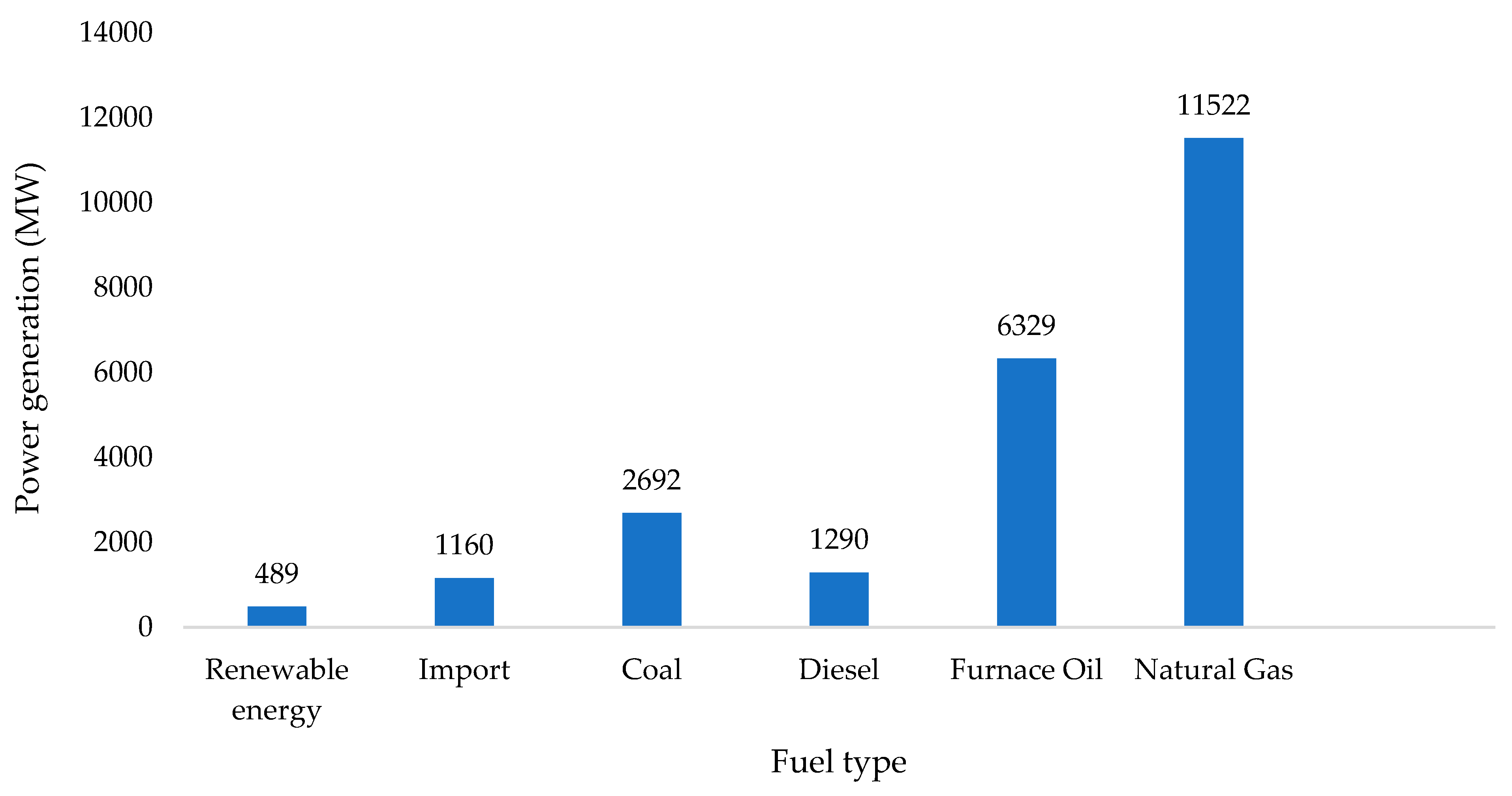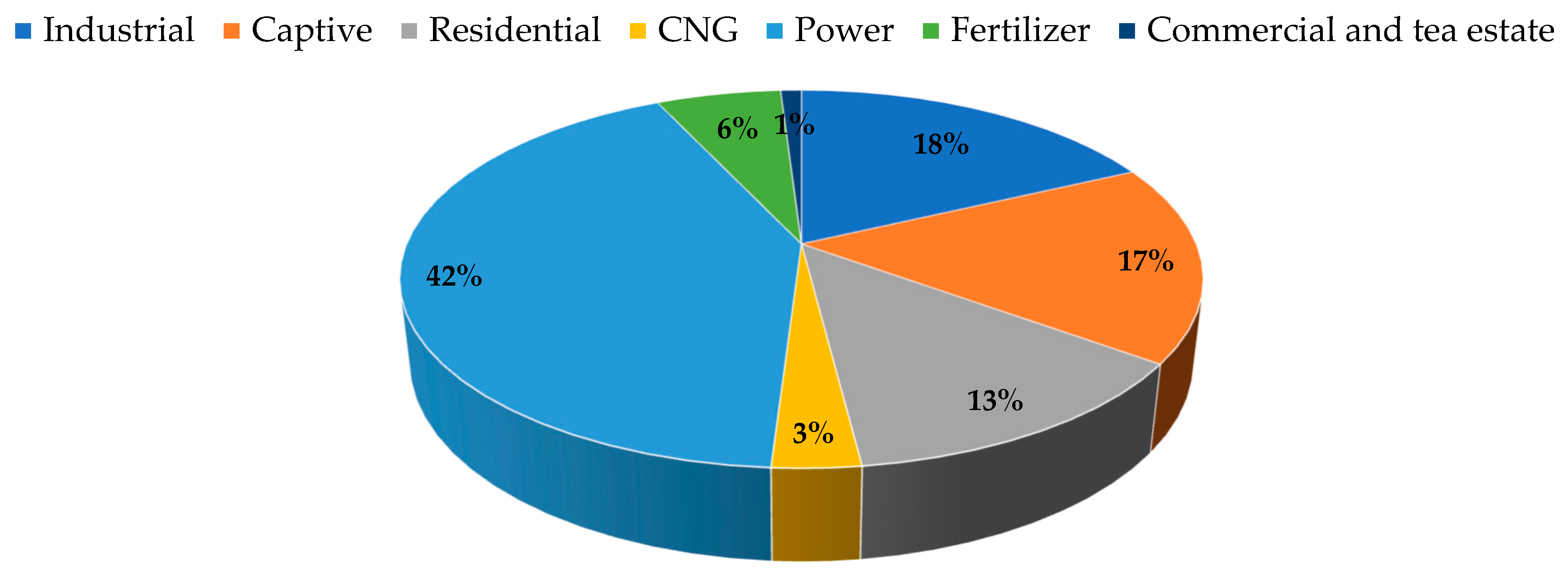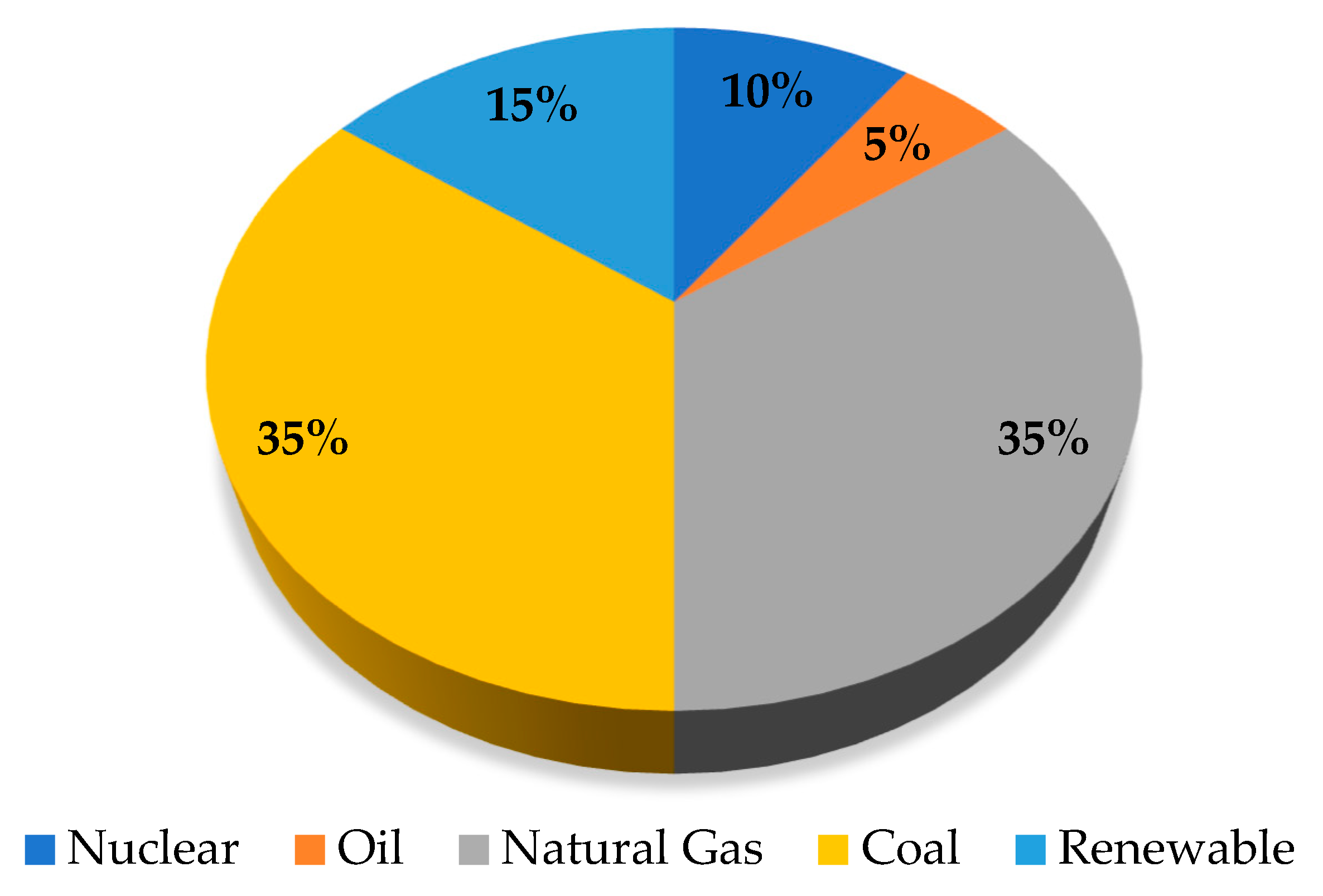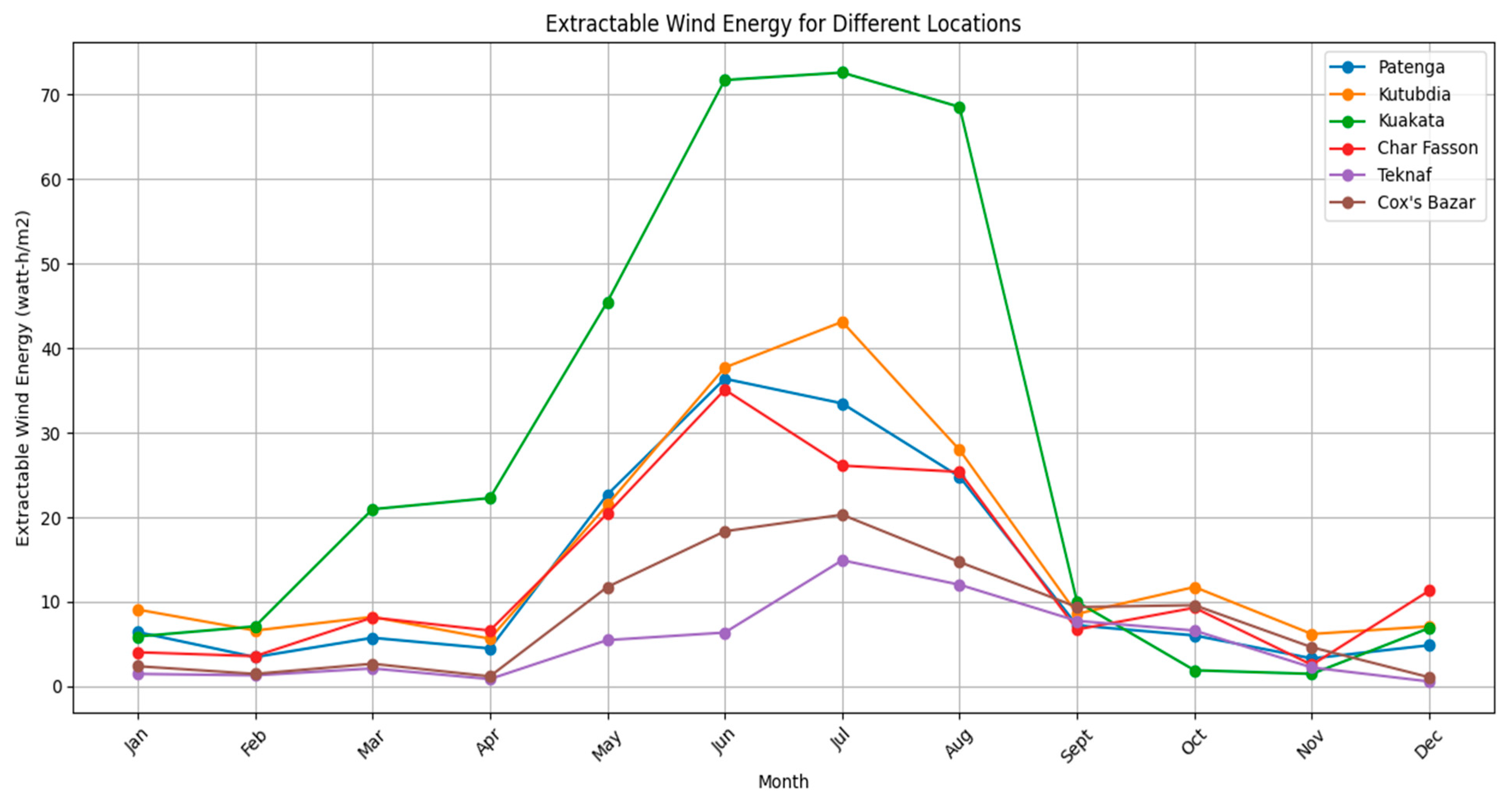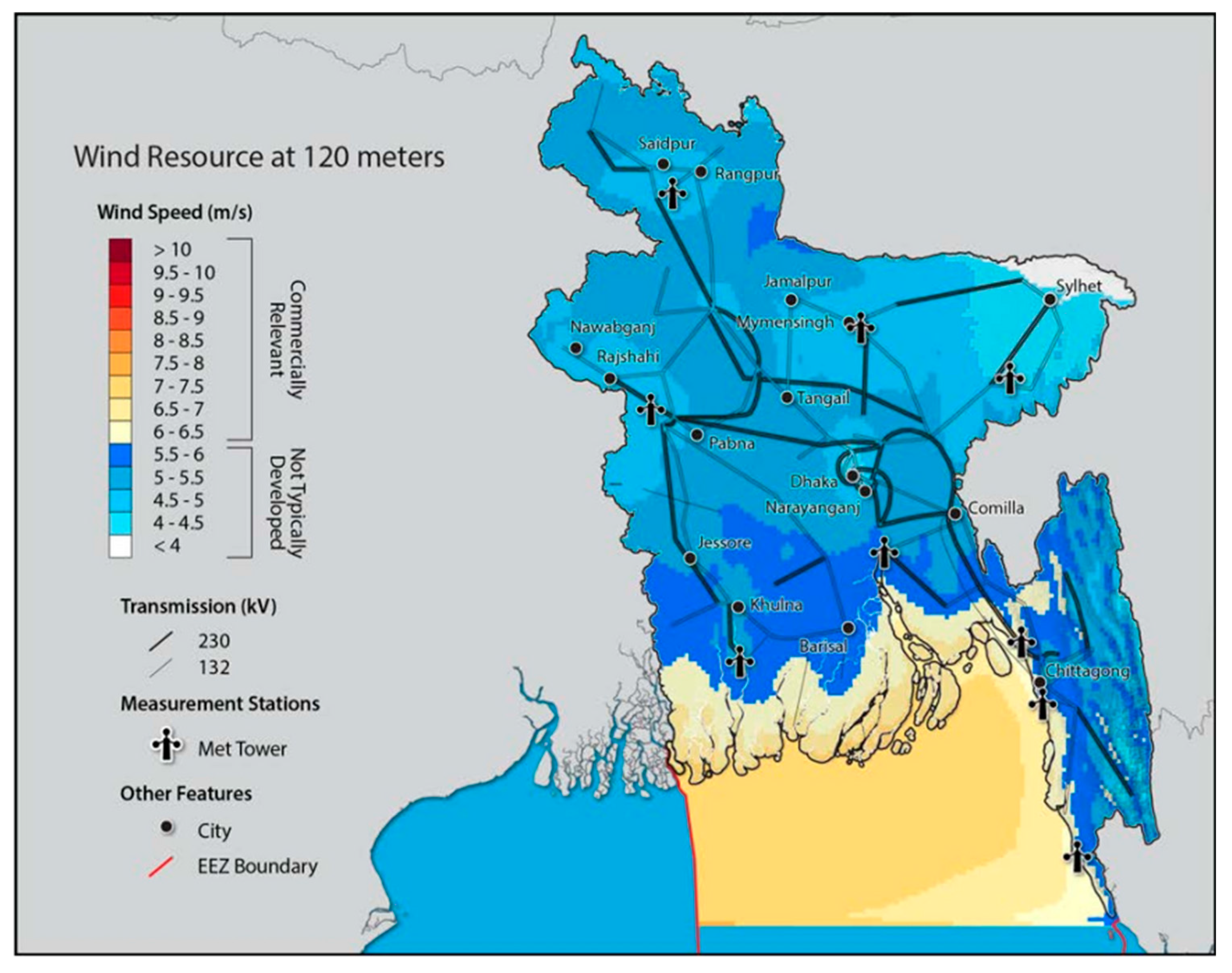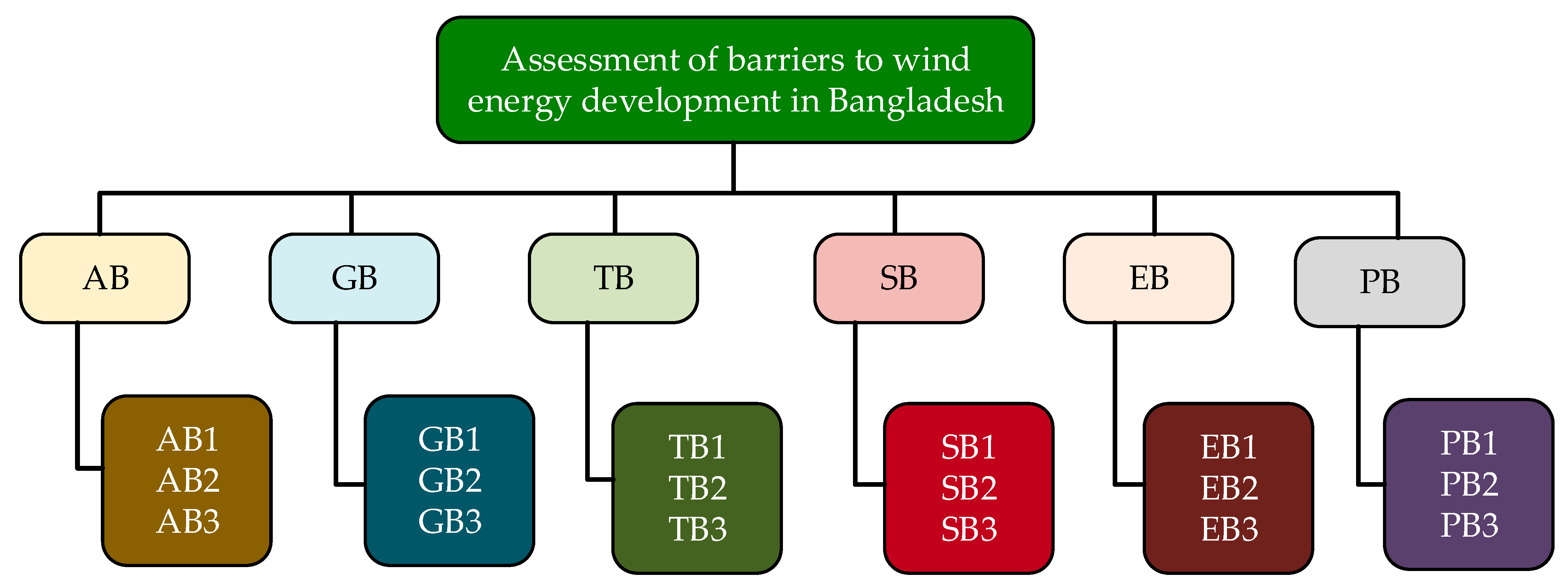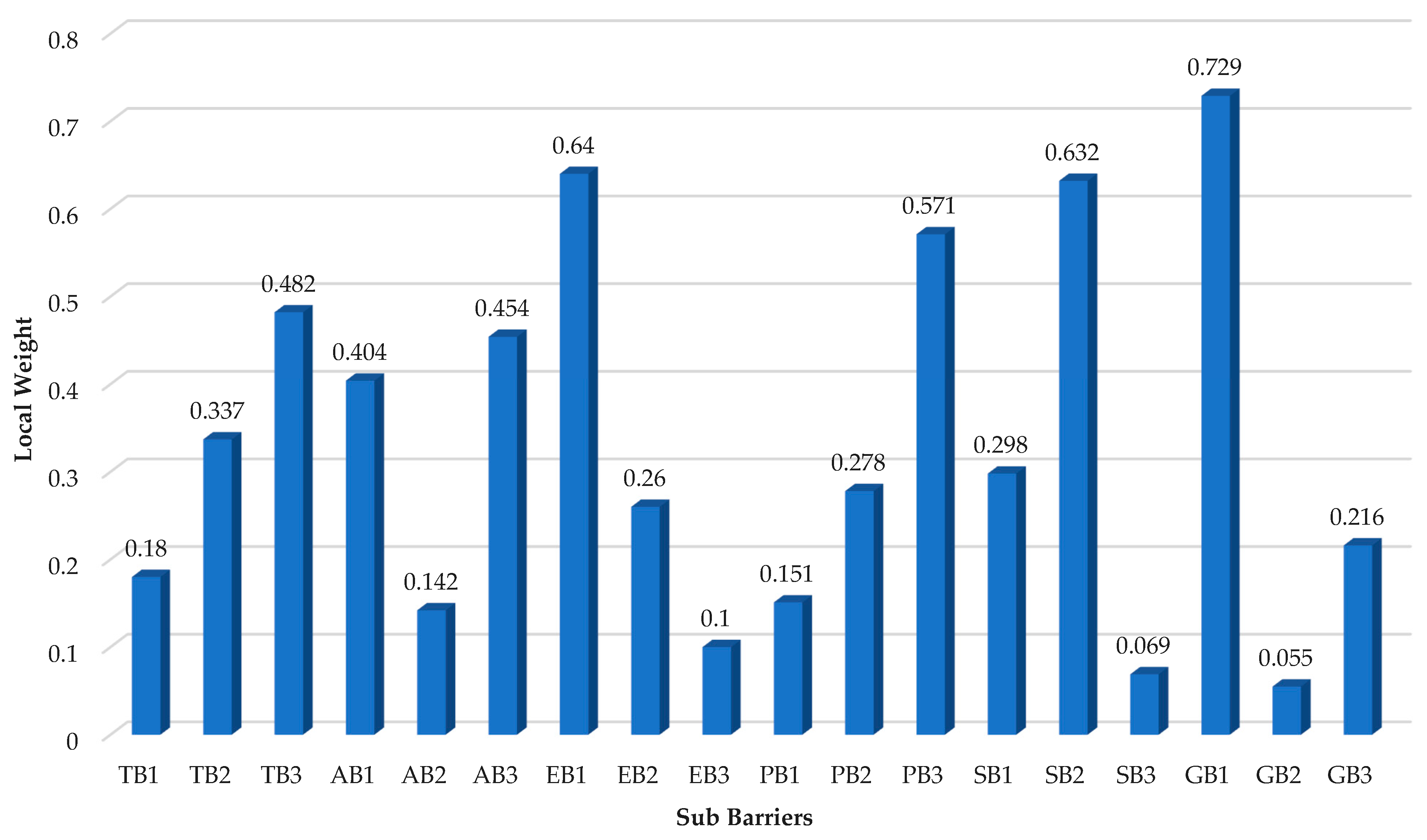1. Introduction
As cities began to develop, energy demand increased tremendously [
1,
2]. Fossil fuels have been used to meet this demand globally [
3]. A significant 4% annual growth in the number of conventional power plants since 1997 has increased air pollution and endangered human health [
4,
5]. These power plants are responsible for one-third of the world’s glasshouse gas (GHG) emissions. The main GHGs that have a negative impact on the global climate order are carbon dioxide (CO
2), nitrous oxide (NOx), and sulfur dioxide (SO
2) [
6,
7]. NOx generated by power plants can form ozone, resulting in environmental photochemical pollution [
8]. Even though technical developments in power plants have significantly reduced SO
2 and NOx emissions, climate change brought on by CO
2 emissions continues to be a severe and divisive issue [
9]. According to estimates, 5% of fossil fuel-based power plants account for 73% of the world’s CO
2 emissions from electricity production, which is highly concerning for the environment [
4,
10]. In underdeveloped nations, the situation is considerably more dire. For instance, Bangladesh is anticipated to produce 83,000 metric tonnes of CO
2 and 132,520 GWh of electricity from conventional power plants in the 2024–2025 fiscal year, making it the top CO
2 emitter in the world [
11]. Therefore, to ensure a low-carbon future and fulfill the Sustainable Development Goals (SDGs), it is required to adopt decarbonization technologies to cut CO
2 emissions and accelerate economic development [
12]. Renewable energy can be beneficial in this regard [
13].
In the wake of the recent Russia–Ukraine war, European nations are anticipated to take considerable action to reduce their reliance on Russian oil and gas [
14]. As a result, a space has been further opened for renewable energy to influence world politics, undermining the dominance of oil and gas exporters [
15]. By the end of 2019, renewable energy sources generated more than 27% of the world’s electricity, with wind turbines and solar photovoltaics (PV) contributing about 11% each [
16]. By the 21st century, it is anticipated that solar and wind energy will increase globally more quickly than other energy sources [
17]. In this context, wind energy can offer grid and off-grid consumers more dependable and efficient power and thus show promise to achieve SDG 7, which means that everyone can afford dependable, sustainable, and modern energy [
4].
Generally, two extraction devices, horizontal-axis wind turbines (HAWTs) and vertical-axis wind turbines (VAWTs), harness wind energy. HAWTs have been widely used between these devices in offshore and onshore locations because of their high power conversion efficiencies. These devices can produce megawatts of power. However, in spite of their commercial success, the large size of HAWTs (rotor diameters over 100 m) presents some logistical problems. HAWTs require large amounts of space in water bodies or land, as the optimum spacing along the wind direction in a HAWTs wind farm could extend up to 15 times the turbine rotor’s diameter or greater. Also, HAWTs require complex yaw control, as they have to face the incoming wind for optimum power production. On the other hand, VAWTs do not require complex control, as their performance is not sensitive to wind direction. Additionally, VAWTs do not create more turbulence in the air downwind of the turbine, and this disturbance returns to the normal state, unlike in HAWTs [
18].
The number of residents living in Bangladesh is 166 million, and by 2041, this number will rise to 189 million [
19,
20]. This year (2041) is significant for Bangladesh because the country aims to achieve high-income status within that year. Bangladesh must put industrialization first to become a high-income nation, which demands a reliable supply of electricity [
21]. However, the electricity demand will be 19,034 MW in 2021 and rise to 82,292 MW in 2041 [
22]. Bangladesh should be self-sufficient in energy generation to satisfy this future increase in electricity demand and become a high-income nation [
23,
24]. As of August 2018, Bangladesh’s current energy mix consisted of 64% natural gas, 21% furnace oil, 6% diesel, 5% power imports, 2% hydro, 2% coal, and 0.1% renewable energy. Despite making up most of Bangladesh’s energy mix, natural gas reserves will run out by 2028 if new gas fields are not found [
25]. Bangladesh’s government relies on imported fuel to power its diesel power plants because it has no oil resources. Therefore, relying on imported fuel cannot be considered a suitable method of achieving self-dependency in electricity production. For its coal-fired power plants, Bangladesh also depends on Australia, India, Indonesia, and Mozambique. However, because Bangladesh’s bituminous coal reserves are comparably high-quality and will be depleted by 2050, using them rather than importing them is preferable [
22]. In addition, a study from the International Energy Agency states that 30% of the CO
2 emissions in the globe come from the generation of energy using coal [
26]. Therefore, using coal is against SDG Goals 13 (Climate Actions) and 7 (Affordable and Clean Energy) [
27]. Also, Bangladesh needs more suitable places to set up nuclear power plants since it is a densely populated country. However, with the help of Russia, a 2400 MW nuclear power plant has been established in Ruppur, Bangladesh. However, more is needed to meet energy demand by 2041 [
22]. Considering these challenges, Bangladesh must focus more on renewable energy, like wind (
Table 1).
Wind energy has enormous potential in Bangladesh. The country has a coastline of nearly 700 km, with strong and persistent winds. The country’s wind energy potential is predicted to be greater than 50 gigawatts (GW). Wind energy growth in Bangladesh is consistent with the country’s larger sustainable development objectives (SDGs). SDG 7 seeks widespread availability of reliable, affordable, and modern energy services. SDG 13 calls for swift action to avert climate change and its effects. Wind energy development in Bangladesh is still in its early phases. However, the nation’s commitment to the environment and sustainable energy goals could benefit significantly from unlocking the huge potential of wind energy. The government’s encouragement of wind energy development is praiseworthy. Bangladesh can fulfil its sustainable development goals while reducing its susceptibility to climate change by investing in wind energy. Several studies have researched the potential of wind energy in Bangladesh. A feasibility study in Chittagong, Bangladesh, claimed vast wind energy potential in Chittagong. For this study, the number of wind turbines required, and their maintenance and operational costs were also determined for their proposed sites [
29,
30]. Similar observations were also made for Bangladesh’s coastal region, as presented in
Figure 1. From
Figure 1, Kuakata and Kutubdia have significant wind resource potential compared to other locations in Bangladesh. Wind speed seems to be higher from June to August. Amin estimates that, except for natural gas and local coal, the unit cost of electricity for wind is far lower than any other fossil fuel and non-conventional energy sources [
31]. Sandwip was found to be an exceptional place for wind energy by Azad et al. after performing numerous Weibull distribution techniques [
32]. Patenga was also an attractive place for wind energy [
33]. This study measured wind speed at 20 m to obtain to this outcome. Another study used the HOMER model and NASA’s SSE wind energy database to generate a wind map [
34]. The study also identified the Enercon (E33) 330 kW turbine as the best wind turbine for Bangladesh for harnessing wind energy. A survey conducted jointly by USAID and NREL in 2018 reported that Bangladesh has the potential to generate 30 GW of energy from wind. This proves a promising aspect of wind energy in Bangladesh [
35]. The wind resources of different parts of Bangladesh can be found in
Figure 2.
Despite this vast potential, wind energy development is restricted in Bangladesh. From the literature review, it is clear that many studies have explored the feasibility of wind energy in Bangladesh. However, barriers that hinder wind energy development are yet to be identified. Several studies have used the analytic hierarchy (AHP) process to identify many countries’ main barriers to renewable energy (RE) development. Pathak et al. used AHP and modified Delphi method to rank barriers to RE technologies in India [
36]. In Malawi, Africa, AHP was used to rank the barriers of RE development. In contrast, Fuzzy TOPSIS (Technique for Order of Preference by Similarity to Ideal Solution) was used to rank the solutions of these barriers [
37]. Solangi et al. also took this same approach for Pakistan [
38]. Ghimire and Kim used AHP to determine the barriers to RE development in Nepal, while Yadav et al. identified barriers to biogas technology in India using AHP [
39,
40]. Shahzad et al. found financial and regulatory frameworks as the main barriers to Pakistan using Pythagorean fuzzy AHP [
41]. Meanwhile, obstacles to RE adoption in Chile were identified by Nasirov et al. using AHP [
42]. This study found that institutional and technological barriers are the main barriers.
Table 2 reports similar studies considering the multi-criteria decision analysis (MCDM) approach to rank and prioritize barriers. This study highlights the obstacles relevant to Bangladesh’s context and geographic location by reviewing the literature from several studies and reports undertaken in other countries. So, in this analysis, an MCDM method named the analytic hierarchy process (AHP) has been employed to identify the main barriers to wind energy deployment in Bangladesh. An extensive literature review was performed to determine these barriers. Government reports, websites, research, and review articles were used for this literature review.
The novelty of this study lies in the following aspects:
It is the first study to use the AHP to identify and rank the barriers to wind energy deployment in Bangladesh.
A comprehensive set of criteria to assess barriers, including technical, administrative, policy and political, economic, social, and geographic barriers, are investigated.
A detailed analysis of the relationships between the barriers and their impact on wind energy deployment are carried out.
The study identifies the most significant barriers to wind energy deployment and provides recommendations for overcoming them.
The paper is organized into five sections.
Section 2 presents the energy scenario in Bangladesh. The comprehensive methods and approaches are outlined in
Section 3. The analysis and evaluation of barriers to wind energy development in Bangladesh are described in
Section 4. The discussion is delivered in
Section 5. The study ends with a conclusion in
Section 5.
2. Energy Scenario in Bangladesh
According to the latest statistics, as of January 2022, Bangladesh produced the highest energy of 13,525 MW, while the total installed capacity was reported to be (as of August 2022) 22,612 MW. The most significant energy came from the private sector (47.39%), followed by the public sector (40.02%) [
50]. The rest came from joint ventures. Foreign countries’ contribution to Bangladesh’s energy consumption was 8.50%. Most electricity (65%) is generated from natural gas (
Figure 3). Apart from power generation, natural gas is widely used in industrial, residential, and commercial sectors. However, this percentage came down to 42% due to the shortage of natural gas (
Figure 4) [
50]. If this continues, the reserve of natural gas will be depleted in the near future. Urgent response is necessary, and shifting to renewable resources is a potential solution to reduce over dependence on natural gas.
In 2021, fossil fuels supplied 99.35% of primary energy. The renewable sources supplied the rest [
51]. As a result, huge amounts of CO
2 are released into the atmosphere. In 2021, Bangladesh emitted 99,297.30 kt of CO
2 into the atmosphere [
22]. To overcome this problem, the Bangladesh government proposed a new electricity mix plan integrating a large share of renewables (
Figure 5).
Figure 5 shows that by 2041, Bangladesh plans to obtain 15% of its electricity from sustainable energy sources [
22]. For this, Bangladesh will mainly depend on solar and wind energy resources.
Figure 3.
Bangladesh’s electricity generation scenario by January 2023 (MW) [
52].
Figure 3.
Bangladesh’s electricity generation scenario by January 2023 (MW) [
52].
Figure 4.
Natural gas contribution in various sectors of Bangladesh [
50].
Figure 4.
Natural gas contribution in various sectors of Bangladesh [
50].
Figure 5.
Energy mix considered by Bangladesh government for 2041 [
22].
Figure 5.
Energy mix considered by Bangladesh government for 2041 [
22].
As previously stated, several studies conducted feasibility studies to find the wind resource potential of different parts of Bangladesh. It should be noted that the highest wind speed found in Kuakata by the WEST project conducted in 1995–1997 was 4.54 ms
−1. Another survey conducted by the WRAP project in 2003 found a wind speed of 6.9 ms
−1 for the same location. Since more recent measuring instruments are more precise than older ones, wind readings from current studies are more largely accepted than those from earlier analyses. After analyzing the one-year wind data from the WEST project, Amin calculated the amount of energy that could be extracted from the wind (
Figure 1).
Table 1 shows how much wind energy can be harvested at 25 m in six potential seashore locations, including Cox’s Bazar, Patenga, Kuakata, Teknaf, Char Fashion, and Kutubdia [
22,
31]. From the table, it is also clear that significant wind energy can be generated between May and August. From the table, it is evident that the highest wind power available is 7.5 ms
−1 at 120 m in offshore and coastal areas. A joint study by NREL and USAID measured the wind speed at 120 m height and prepared a wind map. The report stated that Bangladesh has more than 20,000 km
2 of land on which to harness wind power. From the wind map (
Figure 2), it can be seen that all the coastal areas of Bangladesh fall under the commercially relevant category. All coastal areas have wind speeds between 6.5 and 7 ms
−1. Another good thing is that Bangladesh can generate energy from offshore wind (wind velocity 7–7.5 m/s) [
35,
53]. Wind energy growth in Bangladesh represents a possible path for meeting the country’s expanding energy needs while reducing dependency on fossil resources. This transformation, however, has its challenges, obstacles, and concerns.
Due to its dependence on imported fossil fuels, Bangladesh faces energy security issues, making its energy industry vulnerable to international price swings and supply interruptions [
54]. Wind energy’s intermittent nature adds another layer of complexity to the energy mix, creating concerns about grid stability and energy reliability [
55]. Due to conventional infrastructure, wind power integration into existing energy infrastructure is a significant concern. Despite significant advances in wind turbine technology in recent years, a technological gap has developed in Bangladesh’s wind energy sector. A lack of access to cutting-edge wind turbines and components can hamper wind farms’ efficiency and performance [
56]. Furthermore, an absence of regional research and development initiatives in wind energy technology presents obstacles to adapting to local conditions. Wind energy is frequently produced in remote or rural places, demanding significant changes to the electrical system and infrastructure to deliver power to urban centers [
56]. This poses logistical and financial issues for the government and energy authorities, who must ensure that wind energy is efficiently delivered and distributed. Bangladesh’s regulatory system for renewable energy, particularly wind power, has progressed but still confronts challenges. Inconsistencies in policy, insufficient incentives, and lengthy approval processes might deter investors and project developers [
57]. A robust and stable policy framework is critical for attracting private investment and creating a favorable environment for wind energy growth.
It is critical to balance the benefits of renewable energy with environmental concerns. Wind farms may have environmental consequences like bird and bat collisions, noise pollution, and aesthetics changes to the area. Furthermore, procuring land for wind farm installations might be difficult due to conflicting land-use needs for agriculture and other reasons. Financing appropriate wind energy projects remains a serious concern [
55]. Wind farms’ high upfront capital expenditures and concerns about the return on investment can deter potential investors. This hurdle can be overcome by developing novel finance sources and connecting with international organizations. Wind energy initiatives require public knowledge and social acceptance to succeed. A lack of understanding of the benefits of wind energy and worries about visual impact or interruptions to residents can contribute to opposition. To address these problems, effective community participation and education programs are required. With its vulnerability to sea-level rise and extreme weather events, climate change poses a considerable threat to Bangladesh. Wind energy can help to reduce greenhouse gas emissions, but its long-term impact on climate change mitigation must be carefully assessed. Bangladesh can benefit from international cooperation and partnerships to overcome these difficulties. Collaborative activities can facilitate the development of the wind energy sector by providing access to technology transfer, financial support, and expertise [
54].
Analyzing wind energy barriers in Bangladesh with the Analytic Hierarchy Process (AHP) demonstrates an effective tool for dealing with complicated decision-making processes. To begin, AHP allows for the identification of critical aspects influencing wind energy projects, such as environmental effects, economic feasibility, and societal acceptance. This organized method supports stakeholders in assessing the multifaceted nature of wind energy development. Furthermore, AHP supports prioritizing various aspects, allowing decision-makers to consider them in order of priority. In the context of Bangladesh, where land-use conflicts and environmental issues abound, AHP can assist in determining which criterion should be prioritized when designing wind energy projects. This guarantees that resources are used wisely, and the most pressing concerns are addressed [
58]. AHP also makes it possible to reduce the negative repercussions of wind energy growth in Bangladesh. AHP promotes transparency and consensus-building by incorporating many stakeholders in decision making, such as local communities and environmental organizations. Furthermore, it aids in evaluating alternative solutions and mitigation methods, ensuring that wind energy development is consistent with sustainable practices and the country’s energy goals [
59]. Applying AHP to detect and reduce wind energy development in Bangladesh provides a methodical and comprehensive strategy. It enables decision-makers to make educated choices, prioritize essential aspects, and effectively involve stakeholders, ultimately contributing to the country’s wind energy sector’s long-term success.
